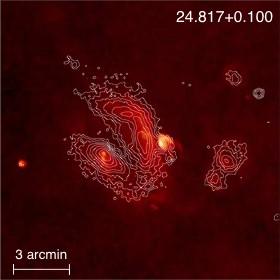
MAGPIS: A Multi-Array Galactic Plane Imaging Survey (2006 AJ Paper)
This section of the MAGPIS website provides access to the
catalogs/tables and
images discussed in the first MAGPIS
paper:
"MAGPIS: A Multi-Array Galactic Plane Imaging Survey"
Helfand, Becker, White, Fallon, & Tuttle,
2006, Astronomical Journal, 131, 2525
We present the Multi-Array Galactic Plane Imaging Survey (MAGPIS), which
maps portions of the first Galactic quadrant with an angular resolution,
sensitivity and dynamic range that surpasses existing radio images of the
Milky Way by more than an order of magnitude. The source detection
threshold at 20 cm is in the range 1-2 mJy over the 85% of the survey
region (5° < l < 32°, |b| < 0.8°) not covered by bright extended
emission. We catalog over 3000
discrete sources
(diameters mostly <30 arcsec) and present an
atlas
of ~400 diffuse emission regions. New and
archival data at 90 cm for the whole survey area are also presented.
Comparison of our catalogs and images with the MSX mid-infrared data allow
us to provide preliminary discrimination between thermal and non-thermal
sources. We identify forty-nine high-probability
supernova remnant candidates,
increasing by a factor of seven the number of known remnants with diameters
smaller than 5 arcmin in the survey region; several are pulsar wind nebula
candidates and/or very small diameter remnants (D<45 arcsec). We report
the tentative identification of several hundred H II regions based on a
comparison with the mid-IR data; they range in size from unresolved
ultra-compact sources to large complexes of diffuse emission on scales of
half a degree. In several of the latter regions, cospatial nonthermal
emission illustrates the interplay between stellar death and birth. We
comment briefly on plans for followup observations and our extension of the
survey; when complemented by data from ongoing X-ray and mid-IR
observations, we expect MAGPIS to provide the most complete census yet
obtained of the birth and death of massive stars in the Milky Way.
The paper is available in
PDF and
gzip-compressed Postscript
formats. It is also available through
astro-ph.
Note that this paper has not yet completed the refereeing process,
so it may change before publication. We are making this
preliminary version available because we believe it is useful
to users of the MAGPIS data.
Richard L. White, rlw@stsci.edu
2006 May 6

